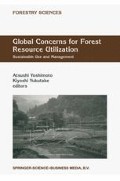Abstract
In this paper we present a spatial and temporal market equilibrium model for Japanese lumber markets in conjunction with a Japanese lumber import model. The proposed model is based on the Samuelson type market equilibrium model with applying a linear function to lumber demand and supply functions in each region as well as a lumber import function. These functions are derived by using price elasticity of lumber demand and supply, which is estimated by using annual regional lumber production and consumption data from 1974 to 1995. As for the import model, data from 1970 to 1996 are used to estimate the price elasticity. Japanese lumber markets are divided into eight regional markets, i.e., Tohoku, Kanto, Hokuriku, Chubu, Kinki, Chugoku, Shikoku, and Kyushu. We consider three types of lumber in the model; Japanese domestic lumber, lumber processed in Japan from logs imported from the United States, and imported lumber. We investigate possibilities of increasing lumber production in Japan using different assumptions in the model specification and market situation. Our simulation analysis indicates that reduction of U.S. log imports does not have much influence on domestic lumber production, but instead accelerates lumber imports to Japan, which can be observed mainly in Kanto.
Access this chapter
Tax calculation will be finalised at checkout
Purchases are for personal use only
Preview
Unable to display preview. Download preview PDF.
References
Flora, D., and Lane, C. 1994. Equilibrium modeling of pacific rim trade in logs and lumber. Journal of Forest Economics. 126: 9–11.
Furuido, H., Kato, T., Inoue, M., Nagata, S., and Oka, H. 1991. Econometric analysis of forest products trade in the pacific region (1) Softwood lumber exports from USA to Japan. Transactions of the Annual Meeting of the Japanese Forestry Society. 102: 33–35.
Gallagher, P. 1980. An analysis of the softwood log trade between the United States and Japan. Technical Bulletin 330 Forestry Series. 34: 2–19, Agricultural Experiment Station, University of Minnesota.
International Monetary Fund. 1997. International financial statistics yearbook. International Monetary Fund. Washington, DC. 827 p.
Johnson, K.N., and Stuart, T.W. 1987. FORPLAN Version 2: Mathematical programmer’s guide. USDA For. Serv., Land Management Planning Systems Section, Washington, DC.
Labys, W.C. 1989. Spatial and temporal price and allocation models of mineral and energy markets. P. 17–47 in Labys, W.C., Takayama, T., Uri, N.D. (eds.), Quantative methods for market-oriented economic analysis over space and time. Avebury, Vermont.
McKillop, W.L.M. 1973. Structural analysis of Japanese-North America trade in forest products, Forest Science. 19: 63–74.
Ministry of Construction, 1975–96. Annual statistical report of construction. Ministry of Construction. Kensetu Bukka Kyokai, Tokyo.
Mori, Y. 1991. Timber market in Japan: An econometric analysis. Memoirs of the College of Agriculture, Kyoto Univ., 179–191.
Murtagh, B.A., and Saunders, M.A. 1993. MINOS 5.4 user’s guide (preliminary). Department of Operations Research, Stanford University, California. 135 p.
Nagata, S., Furuido, H., Kato, T., and Oka, H. 1992. Econometric analysis of forest products trade in the pacific region (2) Making of an econometric model for coniferous wood trade between Japan and North America. Transactions of the Annual Meeting of the Japanese Forestry Society. 103: 29–31.
Nomura, I. 1978. Shingaizaidokuhon, Ringyoshinbunsha, 419 p.
Richards, F.J. 1958. A flexible growth function to empirical use. Journal of Experimental Botany. 10: 290–300.
Rinyacho. 1975–96. Annual report. Report on Supply and Demand of Timber. Ministry of Agriculture, Forestry and Fisheries of Japan. Norin Toukei Kyokai, Tokyo.
Rinyacho. 1976–97. Annual statistics survey of forest and forestry. Japanese Forestry Agency. Ringyo Tokei Yoran. Rinya Kousai Kai, Tokyo.
Rinyacho. 1995. Current states of forest resources, Forestry Agency, Tokyo, 90 p.
Rinyacho. 1989. Mokuzaijukyuu-to-mokuzaikougyou-no-genkyo (Current states of demand and ssupply of forest products and forest industries), Forestry Agency, Tokyo, 496 p.
Rinyacho. 1997. Mokuzaijukyuu-to-mokuzaikougyou-no-genkyo (Current states of demand and supply of forest products and forest industries), Forestry Agency, Tokyo, 560 p.
Samuelson, P. A. 1952. Spatial price equilibrium and linear programming, The American Economic Review. 42: 283–303.
Tachibana, S. 1994. An econometric analysis of timber trade between Japan and North America: Relationship between the environmental conservation movement and the timber trade, Journal of Forest Economics. 125: 36–41.
Vincent, J. R., Brooks, D. J., and Gandapur, A. K. 1991. Substitution between tropical and temperate sawlogs. Forest Science. 37: 1484–1491.
Yukutake, K. 1984. Econometric analysis of South Sea and USSR log market in Japan. Journal of Agricultural Research Quarterly. 17: 269–279.
Yukutake, K. 1985. Simulation analysis of log and lumber: Econometric model for Japan. The Current State of Japanese Forestry. 4: 1–14.
Yukutake, K., and Yoshimoto, A. 1996. Effects of timber export from North America to Japan on regional timber production: A quantitative analysis using the KoopmansHitchcock type market equilibrium model, Transactions of the Japanese Forestry Society. 107: 413–414.
Yukutake, K., Yoshimoto, A., Nagata, S., and Tachibana, S. 1996. Forest sector modeling in Japan. P. 111–134 in Proc. of Project Group P.6.11 FORESEA Meetings at the 20th IUFRO World Congress, Univ. of Washington.
Editor information
Editors and Affiliations
Rights and permissions
Copyright information
© 1999 Springer Science+Business Media Dordrecht
About this chapter
Cite this chapter
Yoshimoto, A., Kajita, J., Yukutake, K. (1999). Japanese Forest Sector Modeling. In: Yoshimoto, A., Yukutake, K. (eds) Global Concerns for Forest Resource Utilization. Forestry Sciences, vol 62. Springer, Dordrecht. https://doi.org/10.1007/978-94-017-6397-4_15
Download citation
DOI: https://doi.org/10.1007/978-94-017-6397-4_15
Publisher Name: Springer, Dordrecht
Print ISBN: 978-90-481-5320-6
Online ISBN: 978-94-017-6397-4
eBook Packages: Springer Book Archive

